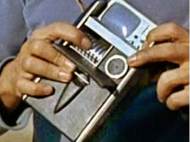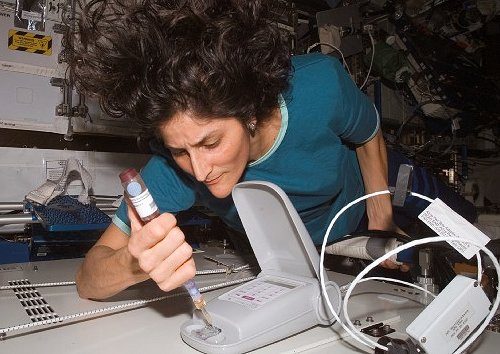NASA’s version of Star Trek tricorder
 Astronauts on the space station have their own version of the “Star Trek tricorder” to search for signs of life, whether that life is from Earth or of extraterrestrial life as we know it. The hand held device acts as a miniature biology lab that allows space station residents to get results on a display screen within 15 minutes.
Astronauts on the space station have their own version of the “Star Trek tricorder” to search for signs of life, whether that life is from Earth or of extraterrestrial life as we know it. The hand held device acts as a miniature biology lab that allows space station residents to get results on a display screen within 15 minutes.
“They like the fact that they can get a result themselves in orbit and not be completely reliant upon the ground or have to send samples back to Earth,” said Jake Maule, a biologist with BAE Systems at NASA’s Marshall Space Flight Center in Alabama.
No instant-scan capabilities exist yet, but the real 21st century tricorder has a handheld advantage over the shoulder-strap tricorder of the original “Star Trek” series that took place in the 23rd century. However, the tricorder of the new “Star Trek” movie also appears to be a hand held device.
NASA first launched the Lab-on-a-Chip Application Development-Portable Test System (LOCAD-PTS) on the space shuttle Discovery in December 2006. Astronaut Sunita “Suni” Williams first tried out the device by swabbing the palm of her hand to get a strong positive reading, before testing some ultraclean water to get a negative reading. Williams ultimately found endotoxins, a marker of certain bacteria, throughout the space station and especially in exercise, hygiene, sleeping and dining areas.
Space station residents also performed the first spacewalk swab in March to see if biological material from Earth might survive the harsh space environment. Understanding the spread of biological material in space could help scientists better avoid potential contamination of future missions to the moon and Mars, Maule said.
Maule worked with Norman Wainwright, a biologist and research director at Charles River Laboratories, to develop LOCAD-PTS. Both conducted tests with the device on NASA’s “vomit comet” aircraft that dives to simulate zero-g conditions.
Testing with LOCAD-PTS requires swapping in different thumb-sized plastic cartridges. Each cartridge carries dried enzymes and colorless dye that turns yellowish-green when it detects bacteria and fungi. Scientists derived the sensitive enzymes from the primitive but highly sensitive immune systems of ancient horseshoe crabs. Just one bacterium can set off the enzymes.
The interchangeability and future cartridges would allow astronauts to monitor their space habitats for common molds. Astronauts currently have three cartridges available to them for detecting levels of gram-positive and gram-negative bacteria, as well as fungi. Future models could include the ability to detect harmful pathogens such as E. coli or salmonella, not to mention ATP energy molecules associated with living things.










Leave your response!